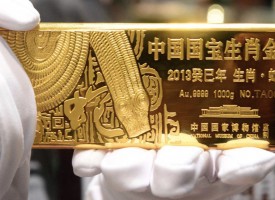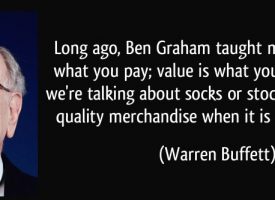We are living through one of the most dangerous times the world has ever faced.
May 23 (King World News) – Dr. Stephen Leeb: This is one of the most difficult, challenging times the U.S. and the world have ever faced. It offers just one potential win-win solution, and that’s gold, both as an investment for individuals and as the essential underpinning of a new world order.
The only thing that can be considered positive about the war in Ukraine is how clearly it has shown that powerful economies, especially democracies, must anchor their growth to the limits imposed by its material foundations. If the best things in life are free, the things needed to run an economy and raise living standards are anything but. As natural resources grow scarcer, any economy that tries to grow without increasing output from fixed amounts of natural resources will run into trouble.
As I’ve said before, the U.S. experienced its greatest times in the half century after the Civil War and the 30 years after World War II. It’s no coincidence that in these periods, the dollar was anchored to a gold standard, ensuring that economic growth was tied to productivity. Growth was aligned with deriving output from units of human labor and units of natural resources.
Today it’s the less developed countries, those with a shorter history of modern finance than the U.S., that better understand why the monetary system should include gold. For example, after Russia’s ruble, about a month after being heavily sanctioned by the U.S., fell 30% below its pre-sanctioned level, Russia’s central bank experimented with an ersatz gold standard. The Central Bank of Russia announced it would buy 1 gram of gold for 5,000 rubles from other banks. which based on the exchange rate at the time amounted to about $1,100 per ounce. The $1,100 figure was meant to establish a lower bound for the ruble.
As it turned out, the lower bound wasn’t necessary. The ruble already had started to advance, and today it sits at multiyear highs against most other currencies. While establishing a relationship between the ruble and gold may have been a psychological plus, the ruble’s gain reflects Russia’s leverage from its commodity abundance during this era of emerging commodity scarcities. This leverage has allowed the country to demand that purchases of Russian commodities be conducted in rubles rather than in dollars or euros.
In today’s world, all economies rely on natural resources, even ones, like the U.S., where the vast proportion of growth is generated by services. I’m not referring to anything as obvious as the importance of food or energy for our survival. In highly developed countries like the U.S., where services represent 80% of our GDP, we tend not to pay a lot of attention to natural resources. Yet natural resources are vital to virtually every aspect of our economy. For example, the computer and related technologies, which are at the heart of much of our economy, require massive amounts of energy, for which oil coal, gas, and nuclear are the major sources. And many other natural resources are similarly critical to our technologies, from helium to cobalt to silver to rare earths…
VERY BIG DEAL!
This exploration company just made one of the biggest
acquisitions of 2021 that stunned investors!
To learn more click here or on the image below

Once we left the gold standard, we have taken natural resources for granted. Other than for brief oil scares in 1973, 1980, and more recently in 2008 and now today, we simply haven’t paid attention. Each year since 1996, the Department of Interior has published an annual review of important commodities and minerals. In 1996, of the 47 commodities it then followed, there were 23 in which the U.S. supplied over 50% or its needs and 24 for which we imported more than 50%. In other words, there was a close to a 50/50 ratio between relative self-sufficiency and relative dependency.
In the 2022 report, in our more complex society, 64 commodities were reviewed. In only 15 of them – less than 25% – were we relatively self-sufficient. Many of the ones for which we depend on other countries are critical to our technologies, perhaps not to the extent that energy is but still enough so that without them, our computers would be slower and much of our sophisticated weaponry would be far less advanced.
Our nonchalance about commodities over the past 50 years reflects that we’ve been able to deal with any problem simply by throwing money at it. Why worry about a commodity whose name you can’t even pronounce when you just can print the money to buy it? With the dollar as the reserve currency, we had carte blanche to print all the money required.
At least, that’s been the case since we left the gold standard in 1971. The wars we have fought this century have cost close to $10 trillion dollars and have used massive amounts of natural resources. It should come as no surprise that the developed world, led by the U.S., uses more than three times as much resources as the rest of the world on a per-capita basis.
But we are starting to pay a price for our indifference to resource scarcity. The Ukraine war and our sanctions, which have backfired on us and even more so on Europe, are revealing the costs to us of so blithely relying on unchecked money creation as the driver of economic growth.
US Will Benefit From Monetary System Linked To Gold
It is past time to pay attention to these many and far-reaching costs, which I briefly summarize below (and detail in my latest book, China’s Rise and the New Age of Gold). It’s important to understand what the costs to us have been, what we’ve lost, because it explains why the U.S. will actually benefit from a new monetary order linked to gold. It will force us to return to the kind of disciplined long-term thinking that once made us such a great country.
We’re at a critical moment of transition. And well may be our last chance to join forces with other countries and together try to save the planet. Until we realize how far astray we’ve gone, and how our presumably beneficial reserve currency status ended up damaging us, we’ll continue trying to block any change in the system. And that would be a fateful mistake.
The first cost can be seen in any chart you can find depicting real wages and productivity. Until the early 1970s, the relationship between the two was close. After we abandoned the gold standard, though, real wages diverged negatively, almost flat-lining. Productivity growth slowed – on average by about 30% – but still continued to rise.
The slowdown in productivity growth was a natural consequence of the rising focus in the U.S. on near-term returns rather than on the longer-term projects that are critical drivers of long-term productivity. In other words, productivity was playing second fiddle to the economy’s major driver, money. The breakdown in the correlation between real wages and productivity was also a consequence of our suddenly having no checks on how much money we could spend.
Essentially the government had the chance to increase its size, and it seized the opportunity. We could dispense with Eisenhower’s warning that every dollar spent on the military was a dollar less for a hungry person. That was true, courtesy of the gold standard, when Eisenhower famously warned about the military-industrial complex. But once off the gold standard, it was easy to create enough money to fund both guns and butter.
It started with the Great Society and the war in Vietnam, which was really the beginning of the end of the gold standard, and continued with the Cold War and the growth in entitlements. And except for a few short years in the 1990s, it has continued through the present. An irony is that while guns and butter may have enabled us to win the Cold War, it has ultimately left us in a much more tenuous position today. As we face off against the world’s less developed countries, we have been weakened as vicious circle after vicious circle has led to a highly indebted and fractured society.
Massive government spending, including on consumer protections, the environment, regulations, you name it, was largely responsible for creating an enormous financial-legal colossus on a par with the military-industrial complex. One result was that money that in the past went to wage earners as a result of increased productivity now went to the layer of society in charge of managing all the newly imposed regulations…
Billionaire Eric Sprott bought a 20% stake in a mining company
that is preparing to announce a massive silver resource
to find out which one click here or on the image below

The holy grail of a successful economy became the stock market. It is interesting that for the postwar period through the early 1970s, the country’s richest man was J. Paul Getty, who made his money in resources – in particular, oil. Today the wealth of the country’s richest comes from the value of their stock holdings. And in this extremely elite group there are no resource titans.
Corporate heads became incentivized to the extreme to make shareholders as rich as possible. Rather than being motivated to support critical research in areas such as material science, corporations went after the low-hanging fruit of consumer spending. Most of the major winners of modern technology in the U.S. have been companies dedicated to incentivizing consumers to spend either on goods or by exchanging information with one another.
It’s true that massive amounts of money also have been spent on both health care and education. But most of this spending has gone to support enormous bureaucracies, while health and education levels for most Americans declined. Today in terms of life expectancy and educational achievement, the U.S. is ranked near the bottom of the developed world. Not surprising, although the U.S. spends tremendous amounts of money on research and development, that spending is by corporations looking for immediate paybacks. That stands in contrast to the pre-1970s era, when most R&D was supported by the government, for example, subsidies for Bell Labs, spending that led to virtually all the technology we enjoy today.
The end result is that in today’s society, the elite depend on continued spending by those Americans who have to go ever more in debt to keep that spending up. Our once-great country is becoming one in which growth comes only from ever more money.
I could say a lot more, and back it up with a lot more statistics. But I hope I have given you a taste of why it is so essential that we opt for cooperation, opt for the discipline of a gold standard that with a lot of work and bargaining could bring the world together. This is the way we can beat the greatest challenge mankind has ever faced, that of resource scarcity. If the war serves as an eye-opener, a vehicle for getting us back to a path we never should have abandoned, then in the end it may have served some purpose. As I said at the start, the potential is there for a win-win resolution, one that revolves squarely around gold. Let’s hope we grab it.
JUST RELEASED: Is A Historic Bull Market In The Mining Shares About To Begin? CLICK HERE.
JUST RELEASED: The Domino-Effect That Would Crush Markets And Economies Faster Than A Hot Knife Through Butter CLICK HERE.
JUST RELEASED: Greyerz Just Warned We Are Entering A Global Depression And The Real Inflation Rate Is 20%-30% CLICK HERE.
***To listen to the man who has become legendary for his predictions on QE and historic moves in currencies discuss the incredibly dangerous scenario the world faces as well as what to expect from major markets including gold CLICK HERE OR ON THE IMAGE BELOW.
© 2022 by King World News®. All Rights Reserved. This material may not be published, broadcast, rewritten, or redistributed. However, linking directly to the articles is permitted and encouraged.








